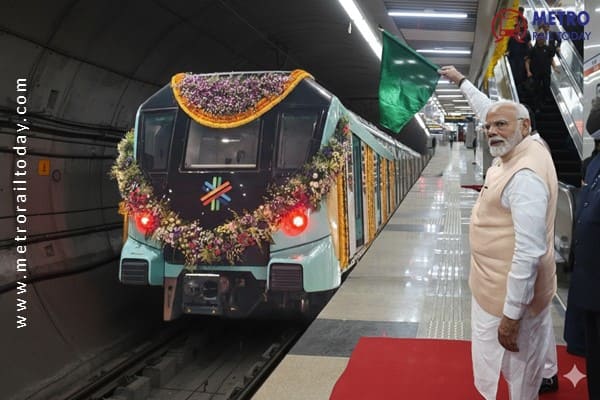 Prime Minister Narendra Modi inaugurates Final Phase of Mumbai Metro Line 3 (Aqua Line)
Prime Minister Narendra Modi inaugurates Final Phase of Mumbai Metro Line 3 (Aqua Line) White Elephants on Rails: How Politically-Driven Metro Projects Are Draining Public Funds?
White Elephants on Rails: How Politically-Driven Metro Projects Are Draining Public Funds? Gurugram Metro Construction Begins with First Piling Work Near Sector 31
Gurugram Metro Construction Begins with First Piling Work Near Sector 31 NCRTC and Gati Shakti Vishwavidyalaya sign MoU to boost Railway Education and Innovation
NCRTC and Gati Shakti Vishwavidyalaya sign MoU to boost Railway Education and Innovation DB Engineering & Consulting partners with GMRC to shape Smart, Sustainable Surat Metro
DB Engineering & Consulting partners with GMRC to shape Smart, Sustainable Surat Metro Patna Metro Inaugurated: First Phase of 3.6-km Stretch Open to Public from October 7
Patna Metro Inaugurated: First Phase of 3.6-km Stretch Open to Public from October 7 Saleem Ahmad appointed as new CMD of Rail Vikas Nigam Limited (RVNL)
Saleem Ahmad appointed as new CMD of Rail Vikas Nigam Limited (RVNL) HCC and Konkan Railway sign MoU to deliver Large-Scale Rail and Metro Projects
HCC and Konkan Railway sign MoU to deliver Large-Scale Rail and Metro Projects Karnataka approves Feasibility Study for ₹20,649 crore Bengaluru–Tumakuru Metro Extension
Karnataka approves Feasibility Study for ₹20,649 crore Bengaluru–Tumakuru Metro Extension Learning from Exits: Re-evaluating the Public-Private Partnership Model in India's Metro Projects
Learning from Exits: Re-evaluating the Public-Private Partnership Model in India's Metro Projects
DMRC submits DPR of ₹5,000 crore Bhubaneswar Metro Rail Project

Bhubaneswar, India (Metro Rail Today): Odisha, a state known for its cultural heritage and diverse landscapes, is now taking a significant stride towards modern urbanization with its maiden metro rail project. Recently proposed, this ambitious initiative has reached a pivotal juncture as the Delhi Metro Rail Corporation (DMRC) has presented a comprehensive Detailed Project Report (DPR) for the project's inaugural phase spanning 26 km, boasting a network of 20 strategically located stations.
In a meticulous display of planning and execution, the DMRC conducted an array of surveys and assessments, including traffic analysis, topographic evaluations, geo-technical investigations, and comprehensive environmental and social impact studies. Harnessing the data gleaned from these endeavors, the DMRC has meticulously fashioned the DPR, which was formally submitted to the State Chief Secretary on a recent Wednesday.
The task of executing this transformative project rests upon the shoulders of the Bhubaneswar Metro Rail Corporation Limited (BMRCL), a dedicated entity constituted specifically for this purpose. The Bhubaneswar Metro Rail Corporation Limited, officially notified on August 3, 2023, has swiftly assumed its responsibilities, appointing a CEO and a General Manager (Administration).
According to the DPR, Phase 1 of the Bhubaneswar Metro Rail Corporation Limited is poised to connect a series of pivotal landmarks, seamlessly integrating them into a cohesive urban transit network. The planned route encompasses Biju Patnaik Airport, Capital Hospital, Sishu Bhawan, Bapujinagar, Bhubaneswar Railway Station, Ram Mandir Square, Vanivihar, Acharya Vihar Square, Jaydev Vihar Square, Xavier Square, Rail Sadan, District Centre, Damana Square, Patia Square, KIIT Square, Nandan Vihar, Raghunathpur, Nandankanan Zoological Park, Phulapokhari, and Trisulia Square in Cuttack.
This transformative project holds immense promise, especially in the backdrop of Odisha's bustling urban landscape. The metro rail system is poised to interconnect key cities, including Bhubaneswar, Cuttack, Khordha, and Puri. It aims to alleviate the challenges posed by rapid urbanization, transforming the twin cities of Bhubaneswar and Cuttack into a singular urban hub. This unification will significantly ease the daily commute of thousands, especially students and professionals, who currently traverse these cities for work and education.
As Odisha aspires to forge a cohesive urban conglomerate, amalgamating several urban zones, including Bhubaneswar, Cuttack, Khordha, Puri, and Jatani, the metro rail project emerges as a vital catalyst in this vision. With its potential to redefine urban connectivity, alleviate congestion, and foster efficient transportation, this landmark project could well be the precursor to a new era of modernization in the state.
Stay tuned as Odisha's urban landscape takes a monumental leap forward, propelled by the momentum of the state's maiden metro rail venture. This transformation is set to redefine the dynamics of daily life, business, and education across the region.




